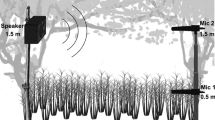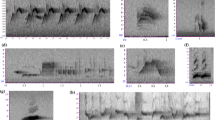Summary
-
1.
Attenuation of white noise and pure tones from 350 Hz to 10 kHz was measured at three secondary forest sites in Panama at different stages of maturity. Graphs of excess attenuation (E.A.) versus frequency were obtained near ground level, and at heights of 1, 2, 5, 10, and 12 m in each habitat.
-
2.
The pattern of E.A. vs. frequency was similar for all habitats. For all heights other than ground level and 1 m the lower the frequency the better the sound carried. Sounds below 2 kHz were attenuated by a ground effect if the source was 1 m or less from the ground. Consequently there was a minimum of E.A. in all three habitats between 500 Hz and 2 kHz at ground level and 1 m.
-
3.
Relevance of the data to assessment of the role of environmental variables in the natural selection of vocalization for long-distance transmission is discussed. Two facts mitigating against Morton's sound “window” as an explanation for lower frequencies in songs of forest as opposed to open country birds are presence of similar “windows” in both habitats and restriction of windows to a zone close to the ground in most habitats.
Similar content being viewed by others
References
Aylor, D.: Noise reduction by vegetation and ground. J. acoust. Soc. Amer. 51, 197–205 (1971)
Baeumer, E.: Lebensart des Haushahns, dritter Teil — über seine Laute und allgemeine Ergänzungen. Z. Tierpsychol. 19, 394–416 (1962)
Busnel, R.G., Gramet, P.: Recherches préliminaires sur le comportement acoustique de Quelea quelea quelea Latham en captivité. Bull. I.F.A.N. 18, 280–326 (1956)
Chappuis, C.: Un exemple de l'influence du milieu sur les emissions vocales des oiseaux: l'evolution des chants en foret equitoriale. Terre et Vie 25, 183–202 (1971)
Collias, N.E.: A spectrographic analysis of the vocal repertoire of the African Village Weaverbird. Cordor 65, 517–527 (1963)
Embleton, T.F.W., Piercy, J.E., Olson, N.: Outdoor sound propagation over ground of finite impedance. J. acoust. Soc. Amer. 59, 267–277 (1976)
Gautier, J.P.: Etude morphologique et fonctionelle des annexes estralaryngees des cercopithecinae; liason avec les cris d'espacement. Biological Gabonica 7, 229–267 (1971)
Green, S.: Variation of vocal pattern with social situation in the Japanese monkey (Macaca fuscata): A field study. In: Primate behavior, Vol. 4 (ed. L.A. Rosenblum), pp. 1–102. New York. Academic Press 1975
Griffin, D.R.: The importance of atmospheric attenuation for the echolocation of bats (Chiroptera). Anim. Behav. 19, 55–61 (1971)
Ingard, U.: On the reflection of a spherical sound wave from an infinite plane. J. acoust. Soc. Amer. 23, 329–335 (1951)
Ingard, U.: A review of the influence of meteorological conditions on sound propagation. J. acoust. Soc. Amer. 25, 405–411 (1953)
Konishi, M.: The role of auditory feedback in the vocal behavior of the domestic fowl. Z. Tierpsychol. 20, 349–367 (1963)
Konishi, M.: Comparative neurophysiological studies of hearing and vocalizations in songbirds. Z. vergl. Physiol. 66, 257–272 (1970)
Marler, P.: Tonal quality of bird sounds. In: Bird vocalizations (ed. R.A. Hinde), pp. 5–18. Cambridge: Cambridge University Press 1969
Marler, P.: A comparison of vocalizations of red-tailed monkeys and blue monkeys, Ceropithecus ascanius and C. mitis, in Uganda. Z. Tierpsychol. 33, 223–247 (1973)
Marler, P.: Animal communication. In: Non-verbal communication. Advances in the study of communication and affect, Vol. 1 (eds. L. Krames, T. Pliner, T. Alloway), pp. 25–50. New York: Plenum Press 1974
Marler, P., Hobbet, L.: Individuality in a long-range vocalization of wild chimpanzees. Z. Tierpsychol. 38, 97–109 (1975)
Marler, P., Mundinger, P.: Vocalizations, social organization and breeding biology of the twite, Acanthus flavirostris. bis 117, 1–17 (1975)
Marler, P., Tenaza, R.: Signalling behavior of wild apes, with special reference to vocalization. In: How animals communicate (ed. T. Sebeok), Bloomington: Indiana University Press (in press) (1977)
Marten, K., Marler, P.: Sound transmission and its significance for animal vocalization. I. Temperate habitat s. Behav. Ecol. Sociobiol. 2, 271–290 (1977)
Mayfield, H.: Hearing loss and birdsong. Living Bird, 167–175 (1966)
Morton, E.S.: Ecological sources of selection on avian sound. Ph.D. diss. Yale University (1970)
Morton, E.S.: Ecological sources of selection on avian sounds. Amer. Natur. 108, 17–34 (1975)
Sokal, R.F., Rohlf, F.J.: Biometry: The principles and practice of statistics in biological research. San Francisco: Freeman 1969
Waser, P., Waser, M.S.: Experimental studies of primate vocalization: Specializations for long distance propagation. Z. Tierpsychol. (in press) (1977)
Wiener, F.M., Keast, D.N.: Experimental study of propagation of sound over ground. J. acoust. Soc. Amer. 31, 724–733 (1959)
Wiley, R.H., Richards, D.G.: Physical constraints on acoustic communication in the atmosphere. (in press)
Author information
Authors and Affiliations
Rights and permissions
About this article
Cite this article
Marten, K., Quine, D. & Marler, P. Sound transmission and its significance for animal vocalization. Behav Ecol Sociobiol 2, 291–302 (1977). https://doi.org/10.1007/BF00299741
Received:
Published:
Issue Date:
DOI: https://doi.org/10.1007/BF00299741




